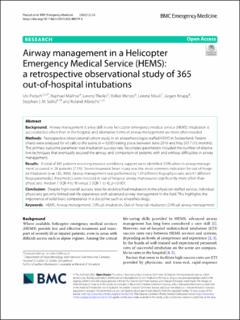| dc.contributor.author | Pietsch, Urs | |
| dc.contributor.author | Müllner, Raphael | |
| dc.contributor.author | Theiler, Lorenz | |
| dc.contributor.author | Wenzel, Volker | |
| dc.contributor.author | Meuli, Lorenz | |
| dc.contributor.author | Knapp, Jürgen | |
| dc.contributor.author | Sollid, Stephen J. M. | |
| dc.contributor.author | Albrecht, Roland | |
| dc.date.accessioned | 2022-06-20T12:15:20Z | |
| dc.date.available | 2022-06-20T12:15:20Z | |
| dc.date.created | 2022-05-19T10:20:55Z | |
| dc.date.issued | 2022-02 | |
| dc.identifier.citation | Pietsch, U., Müllner, R., Theiler, L., Wenzel, V., Meuli, L., Knapp, J., Sollid, S.J.M., Albrecht, R. (2022) Airway management in a Helicopter Emergency Medical Service (HEMS): a retrospective observational study of 365 out-of-hospital intubations. BMC Emergency Medicine, 22:23 | en_US |
| dc.identifier.issn | 1471-227X | |
| dc.identifier.uri | https://hdl.handle.net/11250/2999619 | |
| dc.description.abstract | Background
Airway management is a key skill in any helicopter emergency medical service (HEMS). Intubation is successful less often than in the hospital, and alternative forms of airway management are more often needed.
Methods
Retrospective observational cohort study in an anaesthesiologist-staffed HEMS in Switzerland. Patient charts were analysed for all calls to the scene (n = 9,035) taking place between June 2016 and May 2017 (12 months). The primary outcome parameter was intubation success rate. Secondary parameters included the number of alternative techniques that eventually secured the airway, and comparison of patients with and without difficulties in airway management.
Results
A total of 365 patients receiving invasive ventilatory support were identified. Difficulties in airway management occurred in 26 patients (7.1%). Severe traumatic brain injury was the most common indication for out-of-hospital Intubation (n = 130, 36%). Airway management was performed by 129 different Rega physicians and 47 different Rega paramedics. Paramedics were involved in out-of-hospital airway manoeuvres significantly more often than physicians: median 7 (IQR 4 to 9) versus 2 (IQR 1 to 4), p < 0.001.
Conclusion
Despite high overall success rates for endotracheal intubation in the physician-staffed service, individual physicians get only limited real-life experience with advanced airway management in the field. This highlights the importance of solid basic competence in a discipline such as anaesthesiology. | en_US |
| dc.language.iso | eng | en_US |
| dc.publisher | BioMed Central | en_US |
| dc.rights | Navngivelse 4.0 Internasjonal | * |
| dc.rights.uri | http://creativecommons.org/licenses/by/4.0/deed.no | * |
| dc.subject | akuttmedisin | en_US |
| dc.subject | luftambulanse | en_US |
| dc.subject | HEMS | en_US |
| dc.subject | intubering | en_US |
| dc.title | Airway management in a Helicopter Emergency Medical Service (HEMS): a retrospective observational study of 365 out-of-hospital intubations | en_US |
| dc.type | Peer reviewed | en_US |
| dc.type | Journal article | en_US |
| dc.description.version | publishedVersion | en_US |
| dc.rights.holder | © The Author(s) 2022 | en_US |
| dc.subject.nsi | VDP::Medisinske Fag: 700::Klinisk medisinske fag: 750::Traumatologi: 783 | en_US |
| dc.source.volume | 22 | en_US |
| dc.source.journal | BMC Emergency Medicine | en_US |
| dc.source.issue | 1 | en_US |
| dc.identifier.doi | 10.1186/s12873-022-00579-8 | |
| dc.identifier.cristin | 2025484 | |
| dc.source.articlenumber | 23 | en_US |
| cristin.ispublished | true | |
| cristin.fulltext | original | |
| cristin.qualitycode | 1 | |

